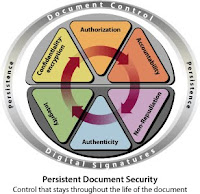The primary purpose of document control is to ensure that only current documents and not documents that have been superseded are used to perform work and that obsolete versions are removed. Document control also ensures that current documents are approved by the competent and responsible for the specific job persons and are distributed to the places where they are used. In regulated industries, this function is mandatory.
If a company is ISO 9001 compliant, it has document control it place. Document control is a part of ISO 9001 and GMP/GxP requirements.
If a company is ISO 9001 compliant, it has document control it place. Document control is a part of ISO 9001 and GMP/GxP requirements.
There are four steps in the document control system:
1. Define the scope of the document control system (which documents must be controlled).
2. Develop a document authorization or approval system.
3. Ensure that only current versions of documents are used at the work places where they are used.
4. Out of date documents that need to be archived must be suitably identified.
Let's look at these steps more closely.
1. Identify which documents need to be controlled
The first task is to identify which documents need to be controlled.
The most important rule of document control is that only current documents must be used for work. You may find that other documents are less vital and it may not be worth the effort of controlling them.
You may even decide to have different levels of document control for different types of documents, e.g. formal approval and controlled distribution for procedures and work instructions, controlled distribution for your list of legal requirements, etc.
2. Define a document approval system
An approval/authorization system ensures that distributed documents are appropriate for persons receiving them. A responsible person must approve these documents. This approval can be in two different forms: on paper documents it will be a signature, on electronic documents it will be either electronic signature or they may only be published when they are approved. If there is no electronic signature, the approval usually can be verified through electronic workflow the document went through to get approved.
When a new document is created or a document is going through a change, Engineering Change Order (ECO) is used to document and approve the document creation or changes. It can also be called Engineering Change Notice (ECN) or Document Change Notice (DCN). ECO outlines the proposed change, lists the product or part(s) that would be affected and requests review and approval from the individuals who would be impacted or charged with implementing the change. ECOs are used to make modifications to components, assemblies, associated documentation and other types of product information.
The change process starts when someone identifies an issue that may need to be addressed with a change to the product. It ends when the agreed-upon change is implemented. ECOs are used in between to summarize the modifications, finalize the details, and obtain all necessary approvals.
3. Assure appropriate distribution
During this step, you need to make sure that everyone who needs the document gets a copy.
Distribution may be physical (paper documents) or electronic. When posting the document on intranet or other electronic systems, ensure that everybody who needs to have the new document knows about the posting (e.g. through an email or workflow notifications). When distribution is physical (paper documents), documents need to be stamped to identify that this is a controlled document and that a user of this document needs to verify that this is the most current version before starting work.
An inventory of controlled documents should be created with the exact location of each controlled document.
4. Remove old and obsolete documents
This is easy if you use an electronic documentation management system but is more complicated with paper documents.
You may request the receiver of new documents to send back obsolete ones. If for some reason you need to retain obsolete versions of documents, they need to be marked to avoid unintended use. Many organisations use a stamp: "obsolete document".
Next time: I am going to talk more about ECO and engineering change process.


No comments:
Post a Comment